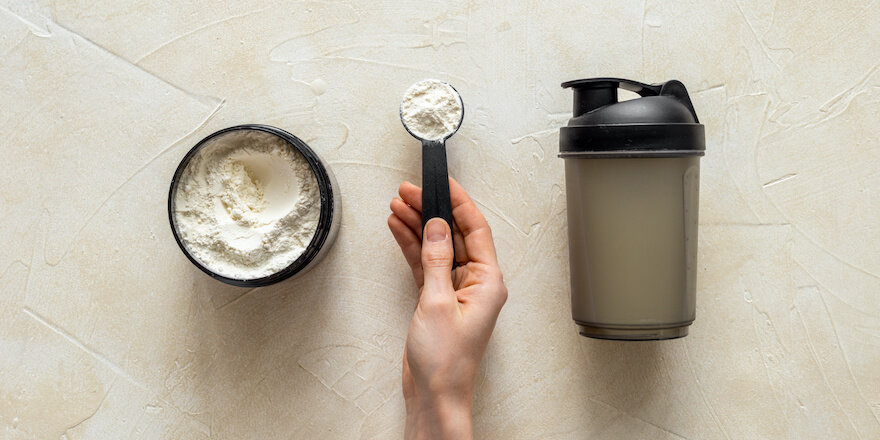Known as whey in French, whey is a protein derived from cow’s milk. You have very likely already seen it as a liquid cloud on the surface of your yogurt.
Unlike casein, whey is not the most abundant protein found in milk. Yet, this “little milk” is particularly interesting for its rapid absorption and anabolic effects.
Whether you are seasoned athletes, bodybuilders seeking improvement, or simply mindful of your well-being, I will explain the benefits of whey isolate compared to regular whey and how it stands out.
📚 Read also | A dietitian tested 10 brands of whey isolate, here are the 4 best ones
1. A higher quality manufacturing process
The result of a filtration of whey, regular whey requires more thermal treatments to obtain.
For whey isolate, it involves ultrafiltration and a more qualitative cold micro-filtration. This major difference makes its consumption more appealing.
2. A higher protein content
While regular whey contains 75 to 80%, the highly filtered whey isolate concentrates 90% of proteins. This can justify its higher cost at purchase.
There are even protein hydrolysates or peptides. This pre-digested form concentrates up to 95% of proteins. Today, we find formulas of isolated proteins with mixed whey hydrolysates.
3. An optimal amino acid profile
This high quantity of proteins offers a more qualitative amino acid profile. The composition in essential amino acids (EAAs) and BCAAs is indeed more substantial.
The BCAAs in whey isolate (leucine, isoleucine, and valine) amount to a minimum of 5 g per shaker. A considerable advantage to meet muscle needs and promote post-workout recovery.
The higher the leucine content in whey, the more you promote muscle building.
4. Low lactose content
Whey isolate is less sweet and less fatty than its counterparts, thanks to the more concentrated proteins it contains.
Most importantly, whey isolate is lactose-free: it contains less than 0.5 g of lactose per 100 g.
Devoid of the main sugar present in milk, whey isolate is therefore suitable for lactose intolerance and causes fewer digestive issues than a regular protein.
This is also what makes it more mixable and often less cloying than other proteins. Whey isolate dissolves better in water without lumps.
5. Rapid assimilation
It takes less than 30 minutes to absorb whey isolate compared to 1 hour on average for regular whey.
Whey isolate is thus a rapid absorption protein, a choice option for those who wish to optimize their post-workout, but not exclusively.

My tips for effectively consuming whey isolate
For better recovery
Its absorption speed is an exceptional asset to repair muscle damage. To replenish the energy spent, as suggested by this study, prepare your whey isolate shaker after exercise with water.
Its anti-catabolic effect can be enhanced in the presence of carbohydrates, so feel free to add a fruit or a cereal bar if needed or some oats in your shake.
To develop your muscle mass
To promote anabolism, that is to develop your muscle mass: take 1 shaker of isolate upon waking every morning. Then on training days, add a second one, after your weight training session.
Its pre-workout use can be interesting if you are fasting: consume a shaker 30 minutes to 1 hour before your workout.
For weight loss
If you want to lose weight, preserving lean mass (muscle) is essential.
Whey isolate can thus accompany a weight loss goal by being included as a protein-rich snack in the morning or at snack time.
Or why not, venture into creating recipes based on whey isolate imagined by many fitness influencers.
To combat muscle wasting
From the age of 30, both women and men experience a decrease in muscle mass.
This physiological phenomenon called sarcopenia can be limited through sports supplementation, as indicated by this study.
Periodically, with a shaker a day, especially in cases of injuries or reduced physical activity, for example.
To meet your protein needs
If you want to reduce meat consumption or eat too few proteins, a chocolate or vanilla drink in the form of a shaker can be a practical alternative.
I recommend integrating whey isolate to complete your daily protein intake which should be:
- between 0.8 g and 1.2 g of protein per kg of body weight for non-athletes
- between 1.5 g and 2.2 g of protein per kg of body weight for athletes
Remember that your body should first be satisfied with your diet. Foods remain the main fuel for your muscles.
Sources and scientific studies
Duarte NM, Cruz AL, Silva DC, Cruz GM, 2020. Intake of whey isolate supplement and muscle mass gains in young healthy adults when combined with resistance training: a blinded randomized clinical trial (pilot study).
Mahdi Gholizadeh, Abolfazl Shakibaee, Reza Bagheri, Donny M Camera, Hossein Shirvani, Frederic Dutheil, 2023. Isolate Whey Protein Promotes Fluid Balance and Endurance Capacity Better Than Isolate Casein and Carbohydrate-Electrolyte Solution in a Warm, Humid Environment.
Nabuco HCG, Tomeleri CM, Sugihara Junior P, Fernandes RR, Cavalcante EF, Antunes M, Ribeiro AS, Teixeira DC, Silva AM, Sardinha LB, 2018. Effects of Whey Protein Supplementation Pre- or Post-Resistance Training on Muscle Mass, Muscular Strength, and Functional Capacity in Pre-Conditioned Older Women: A Randomized Clinical Trial.
Pasiakos SM, McClung HL, McClung JP et al. 2011. Leucine-enriched essential amino acid supplementation during moderate steady state exercise enhances postexercise muscle protein synthesis.
Sonja Graf, Sarah Egert, Martina Heer, 2011. Effects of whey protein supplements on metabolism: evidence from human intervention studies.



